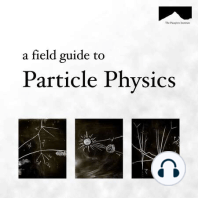4 min listen

The Guide to the Field Guide to Particle Physics
The Guide to the Field Guide to Particle Physics
ratings:
Length:
8 minutes
Released:
Sep 21, 2021
Format:
Podcast episode
Description
Frequently asked Questions about Elementary ParticlesWhat is a particle?A particle is a small packet of energy. It’s nature’s organizational scheme for energy, and energy - so far as we can tell - is never created or destroyed. But it can change forms.Particles can exist for a moment or for an eternity, but they don’t really have a distinct existence. Unlike birds, trees or people have that their own distinct features or personalities, particles of the same species are completely indistinguishable. For example, it is physically impossible to tell one proton from another. How big is a particle?Particles may or may not have a definite size, although it’s usually fine to think of them as extremely small. A particle’s size is usually a determined by their inner workings, by their constituent components. For example, an atom is only as big as the size of its electrons’ orbit, where as a proton is almost a million times smaller! Elementary particles, like electrons, don’t appear to have any internal structure. Those particles don’t even have a well-defined size!What is a charge?Particles are constantly pushing and pulling on each other. A particle’s charge determines how strong it can push or pull. A great example is the electric charge: opposite charges attract and like charges repel. Electrons and protons have equal and opposite electric charges, which is why they attract to form atoms.Charges are associated with the forces of nature, like the electromagnetic force. There are also the strong and weak nuclear forces, and each has its own kind of charge. In some sense, the mass is the charge for the force of gravity. Incidentally, force is just a word for another kind of particle, and we’ll learn all about them in this guide.Two particles of the same species will always have identical charges.What is a particle’s mass?Like you or I, particles can have mass. It’s important to remember that there’s a difference between mass and weight, but they are proportional to each other. Weight is includes the effect of gravity:weight = mass x gravityOn Mars, you’d have the same mass as you do on Earth, but experience a very different weight. Of course, particles are so light that usually gravity has very little influence on their day to day life.Is it mass or energy?It’s both. A particle’s mass and energy are related: E = mc^2This is arguably the most famous equation in physics. It tells us one important thing: as weight is proportional to mass, energy is proportional to mass, squared.This fact has an interesting consequences: mass is also proportional to energy, and that means any kind of energy. If you have a bunch of particles zooming around like bees in a closed box - and the box is just sitting on the floor - that box’s mass is increased by an amount proportional to the energy of those particles inside the box. That constant of pro- portionality is a doozy though, its the speed of light squared, which is 9 with sixteen zeros after it:mass = Energy /90000000000000000So those particles will have to have a lot of energy to appreciably change the mass of the box. One of the best ways to compare particle species with one another is by their mass. Particles of the same species have the precisely the same mass.What is an MeV?Because E = mc^2, physicists measure mass in units of energy. Volts are a pretty standard way to measure electrical energy. Your wall outlet has somewhere between 120 and 240 volts, which, multiplied by a particle’s electric charge gives us the energy:Energy = electric charge × VoltsSo, roughly speaking, and electron - with charge e - comes out of your wall with well over 100 volts times the electric charge or 100 electron volts, or ”eV” for short.A convenient way to measure energy in particle physics is in mega electron volts or MeV. One mega electron volt is million electron volts. Which isn’t as big as it sounds. The mass energy of a hydrogen atom is about one thousand MeV.Incidentally, a GeV or giga electron volt, is a bil
Released:
Sep 21, 2021
Format:
Podcast episode
Titles in the series (49)
The Charged Pion: There are three kinds of pions: pi plus, pi minus and pi zero. Compared to the proton, they’re quite small and a little quirky. They’re certainly unstable. Today we’ll talk about those charged pions, π±. by The Field Guide to Particle Physics